Do you believe soups are better suited for a specific time of the year? Maybe when it is cold and dreary or rainy outside? For Panamanians, soup is on any day of the week and year. As a matter of fact, you’ll find it on the daily lunch menu at every restaurant or Fonda around the country.
When I was in Austin a few weeks ago, I saw an advertisement for Sopa de Arroz con Pollo (Chicken & Rice Soup). Even though I’ve heard about chicken & rice soup, I never really thought about it in a Latin context until then. Chicken & rice soup doesn’t move me in any way, but Sopa de Arroz con Pollo…? Now, that’s a completely different matter. I simply couldn’t get it off my mind. The possibilities. The potential goodness. Muy rico.
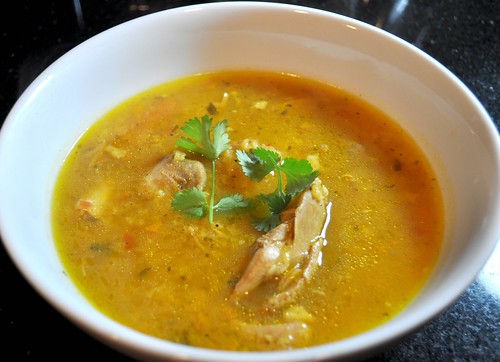
It turned out lighter than I had anticipated, even with the addition of the rice. Rich with the flavors of the chicken broth and culantro. I didn’t have any yuca at home, but next time I make it, I will use that instead of potatoes. And it was a breeze to make too!
Sopa de Arroz con Pollo
1-1/2 lbs of chicken on the bone (I prefer thighs) seasoned with 2 pkts Sazón Goya .
To your blender, add 1/2 onion, 1/2 red bell pepper, 1/4 cp cilantro or 3 culantro leaves and 2 crushed garlic cloves, add just enough water to puree all the ingredients; I ended up with about 3 cps of puree.
Put the seasoned chicken and the puree in a stockpot over medium-high heat and allow it to cook for about 10 minutes, stirring occasionally. This will allow the flavors from the pureed veggies to infuse the chicken before adding all the water for the soup.
After about 10 minutes, add enough water to totally submerge the chicken, about 6 cps, add some chopped potatoes and carrots, season with salt & pepper, and 1 bay leaf. Bring it all to a boil, then lower temperature to allow it to simmer and cook for about 20-30 minutes or until the chicken is tender.
Remove the chicken from the broth and add 1/2 cp of rice to it, allow it cook while the chicken cools enough to remove the bones. Make sure to stir the broth every few minutes, making sure to remove any rice that may stick to the bottom. In the meantime, chop the chicken, if you’d like and return it to the broth. Cook just long enough for the rice to soften.
Serve in bowls and enjoy!
Cookingly yours,
Anamaris
I love learning new things, especially new cooking things. Be it techniques, flavors, ingredients, I love it. The world is so full of delicious and unique goodies, we would need to live several lifetimes in order to appreciate them all. There is a flower/plant that is very popular in Panama, the Caribbean and Mexico. In Panama and the Caribbean it is known as Saril or Red Sorrel. In Mexico, they call it Flor de Jamaica (Jamaican flower) and they use it for their aguas frescas–essentially, flavored (infused) waters.
These next 3 shots were taken by Peter, Mr. P. de Panama. A US expat living in my little country, who kindly allowed me to use his shots in exchange for the link to the recipe featuring them. I think I got the best end of that deal. Definitely take some time to visit his Flickrstream, he has some awesome photos here.
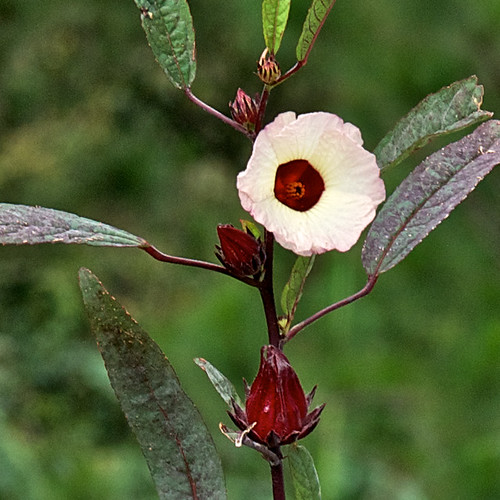
Saril bush, flower and ...the thing you make the juice with
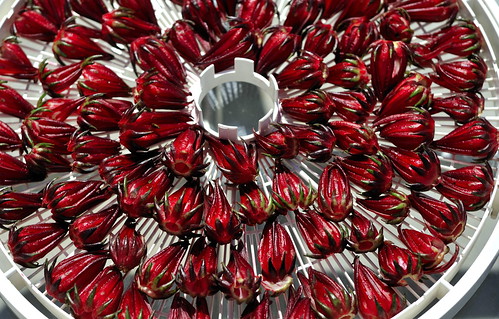
Similarly, I’ve been drinking Ponche de Saril (Saril punch) since I was a little kid; my mom and aunts would sit around for hours piting the flowers, then they would steep them with lots of ginger. To serve it, sugar and sometimes lime juice was added and then the drink is poured over lots of ice. It is one of the most beautiful and refreshing things you’ll ever drink, an awesome combination of tartness and zing. My mouth is watering just thinking about it.
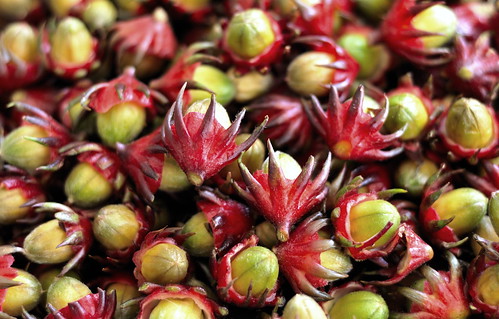
the pits!
That was the only use I was aware of for this flower, a relative of the common hibiscus plant. Recently, I read a post by one of my fave foodies, Lesley over at The Mija Chronicles. She used the reconstituted flowers to make quesadillas, then I discovered she has a fascination with the little flower and has prepared and eaten many dishes incorporating it. To say I was intrigued does not cover it. I couldn’t get it out of my mind. The possibilities seemed endless once I realized the genius of exploiting the flavors of the miracle flower. What to do…?
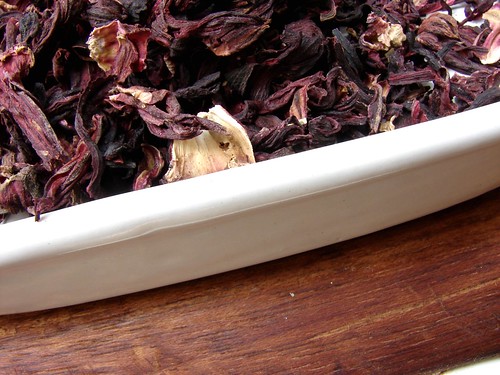
As you can see, the flower is a bright purplish red, the color intensifies when dried. The liquid, broth, tea, water, whatever we should call it, is a beautiful ruby red, a bit more intense than the color of cranberry juice. I wanted to make sure that the dish I created continued to pay homage to the vibrancy of the flower’s color. Saril’s flavor profile could be compared to that of fresh cranberries, I guess. Except, not as tart, giving way to a slight sweetness along the way. Again, I needed to preserve those flavors in the final product: chicken would open itself up to the flavors. A bit of heat and we would be golden. Want to see?
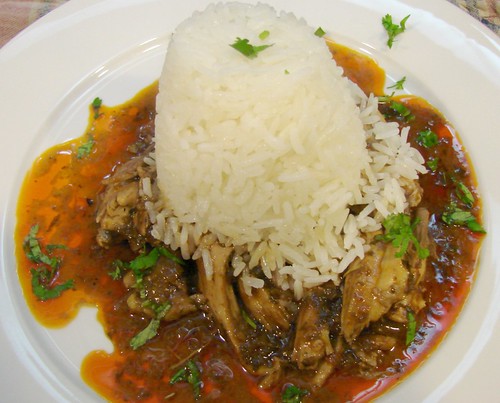
Chicken in Saril and Ancho Sauce
For the chicken
1 whole chicken, cleaned
2 carrots, halved
1/2 cilantro bunch
4 cloves garlic, whole
1 tbsp Herbs d’Provence
1 tbsp sea salt
Water
Remove the innards from the bird’s cavity and rinse the chicken under cold tap water. Place all the ingredients, except for the chicken and water in a stockpot, rest the chicken over them, then fill the pot with enough water to completely cover and submerge the chicken. Place on the stove on high heat until it comes to a boil. Once it boils, lower the temperature just enough to keep it at a slow boil (about medium-high flame) and allow it to cook for another 20 minutes.
At the end of the 20 minutes, turn off the heat and cover with a tight-fitting lid. Let it steam for another 30-45 minutes. Remove the chicken to cool and reserve the broth. This will result in the most beautiful, flavorful, moist chicken meat ever and the broth is amazing. Once the chicken has cooled, break the chicken into pieces and remove the meat from the bones into bite-size pieces. Set aside.
For the sauce
2 cps reserved broth
2 ancho chilies, whole
2/3 cp dried saril
2 tbsp raspadura or dark brown sugar
1-2 tbsp olive oil
1 yellow onion, diced
2 cloves garlic, finely chopped
1/2 cp cilantro, chopped
1 tbsp flour
1/2 cp heavy cream, approx
Reserved chicken broth
Sea salt & black pepper
Place the raspadura, anchos and saril in a small pan with about 2 cps of the chicken broth, bring it to a slow boil for about 10-15 minutes, just until the chilies have softened. Puree in the blender until smooth.
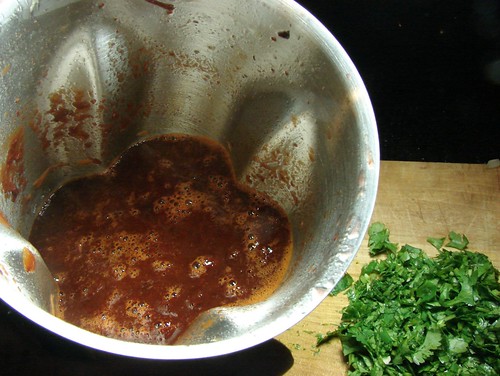
Heat a pan large enough to hold all of the chicken meat and add the olive oil, onions and garlic, cook until the onions are soft and translucent. At this point add the cilantro then the flour and stir constantly over medium heat, don’t let the flour burn, this will help thicken the sauce later. Add the saril puree and enough broth to make the sauce runny, about the consistency of half & half.

Once the sauce thickens a bit, to about the consistency of heavy cream, stir in the cream then add the chicken and lower the temperature to a slow simmer. Allow it to cook for 20-30 minutes, long enough for all the flavors to come together. Serve over white rice, maybe even pasta and be ready to be oh so happy!

To see just a few more pictures of the cooking goodness, go to my Flickr stream, here. Don’t forget to stop by Peter’s page while you’re there. Mil gracias, Pedro!!!
Cookingly yours,
Anamaris
It’s cold in Houston. Like freezing cold. As much as I love the cold, it makes very, what’s the word…? Lazy. Yep. I’ve got a ton of already prepared, shot and eaten dishes to tell you about, but with all the real work I’ve been doing, I’ve not been able to sit before the puter to type ‘em up.
So, we’re going to the mattresses. I mean, the archives. This is what I do when I’ve not had a chance to come up with a new post and when I think there’s something yummy you may have missed in my early days.
This one is really good, it is a creamy and spicy chicken dish with Mexican flair. This is Pollo con Crema Poblana (Chicken with Poblano Cream Sauce). For the recipe, click the link.

Lazily yours,
Anamaris
Wondering whatever you will do with all that leftover turkey? I know I am! I mean, as much as I enjoy the whole meal, I get tired of the original spread after a day of leftovers. I know lots of people enjoy making their leftover turkey into sandwiches, I’m not a big sandwich fan. Can’t tell you why, just not a fan. However, every now and then… something happens and I want one.
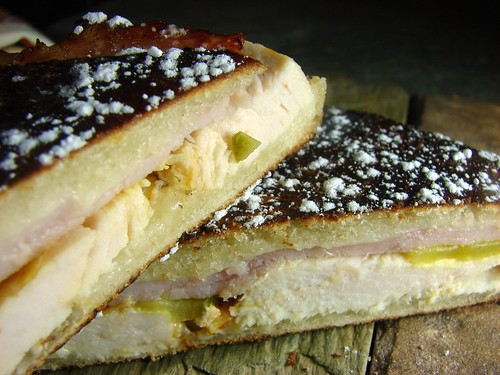
Medianoche literally means midnight in Spanish and that is the name given to this Cuban specialty. They say these came about as a snack offered to night club patrons in the wee hours of partying. I totally understand that. When I’m out late drinking and dancing (not that it has happened in a while), a need a little nibble of something. And, believe me, when you’re on the sofa watching a good movie later on, you’ll be so glad to see this beauty toasting up.
No recipe again, just the ingredients. I should mention that the Medianoche is pretty much the same thing as a Cuban sandwich, except for the type of bread used. If you have a bread that is eggy and slightly sweet, you’ll end up with a Medianoche. On the other hand, if you only have something like a baguette, it’ll be a Cuban sandwich. I used Hawaiian sweet rolls in lieu of a brioche, which aren’t readily available in Houston. The ham is a Boars Head Sweet ham, it wasn’t as sweet as the honey-roasted and worked beautifully. As for cheese, I went with a full-blood Swiss, I wanted to taste it in the sandwich.
Medianoche Sandwich
Bread
Turkey slices, thick slices
Sweet ham
Swiss cheese
Pickles
Butter
Butter the bread slices, then layer with cheese, turkey, ham, pickles, and top with cheese. Put the other half on top.
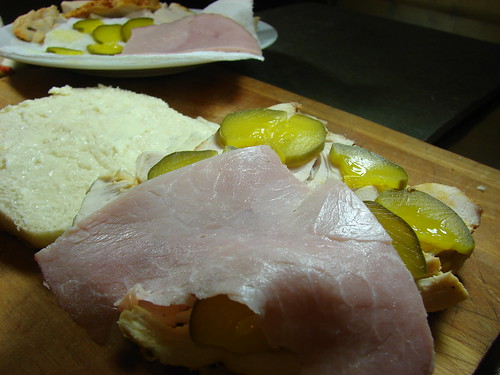
If, like me, you don’t have a Panini press, add a bit of butter to a skillet and heat over medium low temperature. Place the layered sandwich in the skillet, then press down with another pan, weighing it down, if necessary.
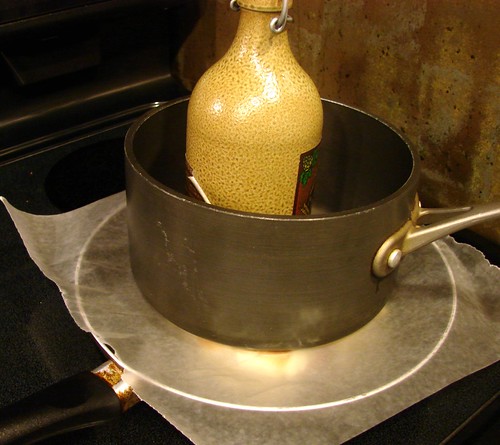
Allow the sandwich to toast for about 3 minutes per side. Make sure the heat isn’t too high or you’ll end up with burnt toast.
Slice the sandwich in half diagonally before serving. For more shots, follow the link to the photostream.

Cookingly yours,
Anamaris
You can find the original recipe to this delicious mole on Rick Bayless’ site or, as I did, on this cookbook. The full version of the recipe includes all the peppers that need to be roasted, rehydrated and blended. I took a shortcut here. Instead of using the various peppers (chiles), I went for a prepared, store-bought mole under the assumption that it would include said peppers. I know. There are a few Mexican grandmothers turning in their graves as I type this. My only hope is that they don’t read English and maybe won’t understand the extent of my trespass. Move on.
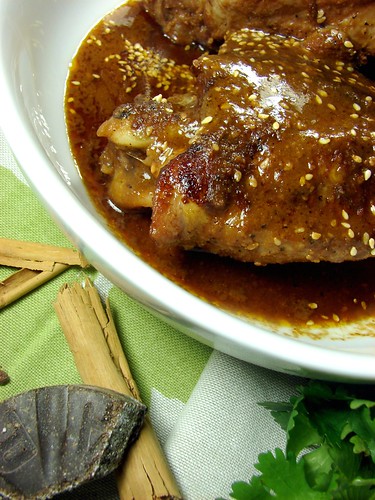
I suppose my shortcut doesn’t allow me to judge the true tastes of the original recipe, but I can tell you that shortcut or no, this recipe rocks! This stuff is so delicious, I considered bathing in it. OK, I know you don’t need that graphic ingrained to your brain. My bad. Anyway, this would be awesome on chicken, pork, seafood, coffee, cookies, eh er…

Turkey in Red Mole Sauce (adapted from Mexico – One Plate at a Time)
makes about 10-12 cups of sauce
5 medium tomatillos, husked and rinsed
1/2 cp sesame seeds
1/2 cp rich pork lard or vegetable oil (I used bacon fat)
4 garlic cloves, peeled
1/2 cp unskinned almonds
1/2 cp raisins
1/2 tsp cinnamon, (use ground Mexican canela if available)
1/4 tsp black pepper, freshly ground
1/4 tsp anise
1/8 tsp cloves
1 cp pre-packaged mole sauce
1 slice firm white bread, darkly toasted and broken into several pieces
1 oz (about 1/3 of a 3.3-ounce tablet) Mexican chocolate, roughly chopped
Salt
4 – 5 tbsp sugar
4 turkey thighs with skin & bones (approx 4lbs)
And now, for the steps:
Roast the tomatillos under a very hot broiler until splotchy black and thoroughly soft, about 5 minutes per side. Scrape into a large bowl.

In a dry skillet over medium heat, toast the sesame seeds, stirring nearly constantly, until golden, about 5 minutes. Scrape half of them in with the tomatillos. Reserve the remainder for sprinkling on the turkey.
In a heavy-bottom pot or dutch over or Mexican cazuela, if you have one of those, heat the bacon fat over medium heat and fry the garlic and almonds, stirring regularly, until browned (the garlic should be soft), about 5 minutes. With a slotted spoon, remove to the tomatillo bowl, draining as much fat as possible back into the pot.
Add the raisins to the hot pot. Stir for 20 or 30 seconds, until they’ve puffed and browned slightly. Scoop them out, draining as much fat as possible back into the pot, and add to the tomatillos. Set the pan aside off the heat.

To the tomatillo mixture, add the cinnamon, black pepper, anise, cloves, bread, mole sauce and chocolate. Add 2 cups water and stir to combine.
In two batches, blend the tomatillo mixture as smoothly as possible (you may need an extra 1/2 cup water to keep everything moving through the blades), then strain it into a bowl and set aside.
If you’re using uncooked turkey, this is when you will season the turkey with salt & pepper. Raise the temperature on the pan to medium-high and brown the thighs on all sides, this will take about 10 minutes. If you make the mole sauce ahead, you can move on to braising the thighs in the sauce. If you are still working on the sauce, go ahead and put the turkey in the fridge while the sauce gets ready.
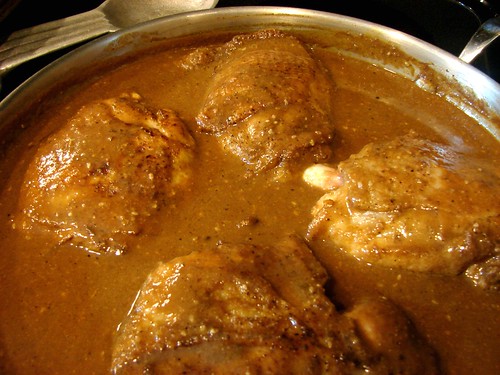
Pour out any excess fat, you only need enough to leave a film on the bottom of the pan. Add the blended tomatillo mixture and cook, stirring every few minutes until considerably darker and thicker, 15 to 20 minutes. You’re looking for the sauce to become the consistency of tomato paste. A word to the wise, use a spatter screen, this mole business is very spitty.
Add 6 cups of water to the pot and briskly simmer the mixture over medium to medium-low heat for 45 minutes for all the flavors to come together and mellow. If the mole has thickened beyond the consistency of a cream soup, stir in a little water. Taste and season with salt and sugar.
Heat the oven to 325°. Lay the turkey in the mole, cover with a lid or foil and place in the oven. Cook until the thighs internal temperature registers 150, this will take about 40-55 minutes. Remove the turkey from the sauce and allow it to rest for a few minutes. Serve with generous amounts of mole sauce.
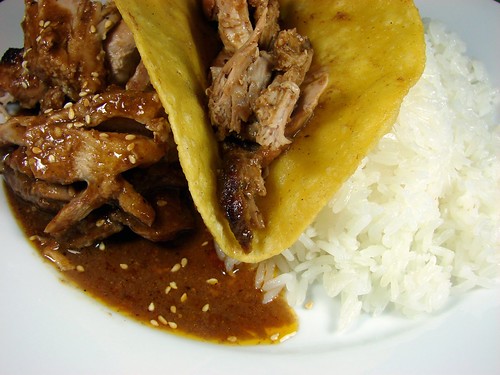
Check out the green mole here and for the rest of the mole porn shots, click here.
Cookingly yours,
Anamaris
This is the fresh mole, that’s what I’m calling it because of A tangy, tomatillo-based sauce, thickened with toasted pumpkin seeds, it’s served with everything from chicken to fish and seafood.
Again, the recipe is based on Rick Bayless’ book, Mexico-One Plate at a Time, I only substituted turkey for chicken. The recipe is pretty straightforward, though there are a few steps to follow. As with the recipe for red mole, you can substitute uncooked turkey with your cooked leftovers. Simply prepare the sauce to completion, then add the cooked meat to heat through.
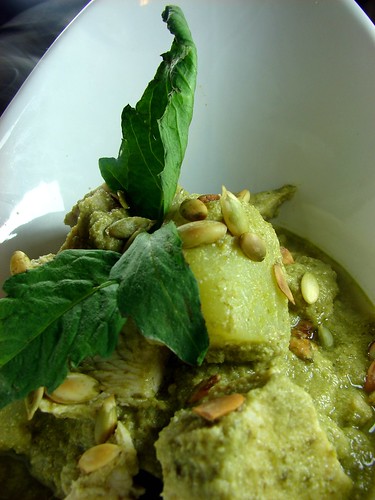
Pavo en Pipián Verde
1 turkey breast or 4 thighs (about 4lbs)
1 small white onion, sliced, divided use
4 garlic cloves, peeled and halved, divided use
1/2 tsp each dried marjoram and thyme
3 bay leaves
Salt to taste
1-1/4 cps hulled, untoasted pumpkin seeds
5-6 medium tomatillos, husked, rinsed and roughly chopped
2 large romaine lettuce leaves, torn into large pieces
2 serranos or 1 jalapeño, stemmed, roughly chopped
Leaves from a small sprig of epazote, plus an additional sprig for garnish
1/2 cp loosely packed chopped cilantro, plus a few sprigs for garnish
1-1/2 tbsp vegetable oil or olive oil
2 medium chayotes
2 medium zucchini
Poach the turkey: In a stock pan, add 10 cups water, half onion, 2 garlic cloves, marjoram, thyme, bay leaves and about 1-1/2 teaspoons salt. Bring to boil. Add the turkey, reduce heat to simmer. Simmer uncovered over medium heat for 20 minutes. Cover pot and let stand off heat for another 30 minutes. Remove turkey from pot. Strain broth and skim off fat that rises to top (can be done 1 day ahead).
Prepare sauce: In a saucepan, Dutch oven or cazuela (a traditional Mexican earthenware casserole with a lid), dry-toast pumpkin seeds. Set pot over medium heat, add the seeds and, when the first seed pops, stir constantly until all have popped from flat to round, about 5 minutes. Don’t let them darken past golden or the sauce will be brownish and slightly bitter. Cool. Set aside 3 tablespoons for garnish and transfer rest to blender.

Add remaining onion and garlic to blender, along with tomatillos, lettuce, chiles, epazote leaves and chopped cilantro. Pour in 1 cup of strained broth; cover and blend to smooth puree (can be done 1 day ahead).
 In In the same pot you toasted the seeds, heat oil over medium-high heat. When hot enough to make a drop of puree sizzle sharply, add it all at once. Stir as mixture darkens slightly and thickens considerably, about 10 minutes. Stir in 2 more cups broth, reduce heat to medium-low and simmer about 20 minutes for flavors to mellow and sauce to thicken to medium consistency (it should coat spoon). Be careful, this is another spitty sauce.
In In the same pot you toasted the seeds, heat oil over medium-high heat. When hot enough to make a drop of puree sizzle sharply, add it all at once. Stir as mixture darkens slightly and thickens considerably, about 10 minutes. Stir in 2 more cups broth, reduce heat to medium-low and simmer about 20 minutes for flavors to mellow and sauce to thicken to medium consistency (it should coat spoon). Be careful, this is another spitty sauce.
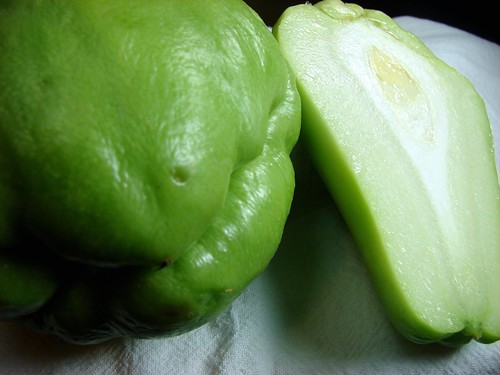
While sauce is simmering, prepare the veggies. Peel the chayote and remove the seed. You may want to do this under running water as chayote has a sap that will stick to your hands and make them turn black. Cube the chayote after peeled, then blanch the vegetables in salted boiling water, cooking chayote about 3 minutes, then adding zucchini for 1 minute. Drain and spread vegetables on plate to stop cooking.
When sauce has simmered 20 minutes, it will likely look coarse. Smooth it to a velvety texture by reblending it in small batches (loosely covered to avoid blender explosions). Return sauce to pan, taste and season with salt, if needed, about 3/4 teaspoon. If sauce has thickened beyond a light cream-sauce consistency, thin it with a little remaining broth.
Remove skin from cooked turkey, if desired, cube and slip into sauce, then add cooked vegetables. Simmer over medium heat just long enough to heat everything, about 5 minutes, then spoon turkey, vegetables and sauce out onto warm serving platter. Sprinkle with reserved pumpkin seeds (you may want to crush them), decorate with sprigs of epazote and cilantro.

For the full mole action, check out the photostream.
Cookingly yours,
Anamaris
I’ve never made mole before. Not really. I wanted to share these recipes with you so you’d have something to work with for Turkey’s Day After. It’s impossible to avoid having 100 lbs of leftover turkey and you can only eat so many sandwiches.
Let me try to describe the flavors of these dishes to you and do them justice. I’ll start by saying they’re similar in the complexity of flavors, at once surprising and familiar. Yet, they’re also in perfect contrast to each other.
Red mole seemed to have an inherent nuttiness that reminded me of peanut butter and the slightly bitter sweetness of chocolate. There’s smokiness that makes you wonder if this is a sauce that was developed from an old roux. It is rich and spicy, not in term of heat but flavor. Yet, it doesn’t taste like 5 different spices, they’re not individually identifiable, but you can tell they’ve come together to bring out the best in each other.

On the other hand, the pipián sauce or green mole tasted light and vibrant, with a nice pungent bite. The lightness of it seeming to fight against the creaminess of the sauce. I’m not sure how to explain it, other than to say it tasted as though we were eating something rich and decadent, while knowing nothing heavy or rich was added.

I’m not going to lie and say these are easy recipes, but they were not too difficult either. Scratch that. They’re not difficult at all, what they are is involved. Lots of steps, which is why I cheated a bit. We have 2 versions of the traditional Mexican sauce: Turkey in Mole Rojo and Turkey in Pipián Verde (green mole).
These recipes come from Bayless’ cookbook, Mexico – One Plate At A Time, and you’ll notice there is at least one other post in the last few days that was inspired by the book. Check out the Green Beans & Carrots in Escabeche. They are incredibly delicious.
A couple of side notes:
- The website recipe is for a very large batch, it’s actually doubled the one in the book. I don’t think you’re feeding a small army, so I’m offering the book version. I had enough sauce to save about 4-6 cps for later use.
- Bayless calls for a whole boneless turkey breast (uncooked). Since I’m not a breast fan, I went with thighs and kept the bones in the mix.
- If you are making this with leftover turkey, simply add the cooked meat once the sauce has reduced.
- I have an old, kick-ass blender that can puree almost anything to a pulp. This is to say I skipped the straining part, you may need to strain it if your blender doesn’t do as well and/or if you have issues with tidbits of sesame seeds.
- Use an oven-safe pan or dutch oven. You will cook on the stove and finish it in the oven.
Are you ready for this? Check out the recipe posts, Turkey in Red Mole and Turkey in Pumpkin Seed Sauce.
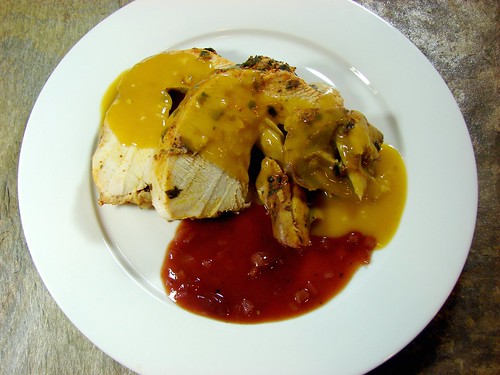
Oh yeah. It’s time to talk about the bird. And this is a very special friend. This has to be my best turkey to date. I’m sorry to gloat, but this turned out perfectly. As I’ve mentioned before, I’m a firm believer in brining turkey. It keeps it moist and juicy and adds a lot of flavor while cooking.
Different from what I’ve done before, I rubbed in an herbed butter before roasting this bird. And since I was going for that Latin flavor, I added achiote paste too. Let me tell you how this all came together.
Achiote & Herbs Turkey with Garlic Butter Gravy
First, the brine. I added a large onion, garlic cloves, bay leaves, celery, Jugo Maggi, salt, sugar and some spices to a large pot of water and brought it to a boil. Allowed it to simmer for about 15 minutes, to infuse the flavors in the water. I then allowed that to cool completely before pouring it into a cooler. Followed by the turkey (giblets removed), then filled with cool water and topped it with plenty of ice to keep it cold overnight.
If you go back a few months, you’ll remember a post I shared for roast chicken, I followed the same principles for the turkey. Incidentally, I want to give a shout out to Noelle over at Portland Palattes, she sent me a note after she followed the same post and ended up with a delicious chicken.

Back to the turkey. I combined 2 sticks of butter (I know!) with achiote paste, garlic, parsley, green onions, orange zest, salt and pepper. After draining and drying the turkey, I then squished the butter under the skin while the oven preheated to 475°. I filled the cavity with whole garlic cloves, quartered orange, celery and carrots, and threw some more at the bottom of the roasting pan.

After inserting the electronic thermometer (love that thing!) I placed the whole thing in the oven for 15 minutes, then lowered the temperature to 325° and roasted it, undisturbed until the internal temp read 185°–about 3 extra hours. No basting, no turning, no nothing. Once it was done, it got a foil blanket and took a little nap for about 30 minutes before I began carving.
The fact that *I* had to do the carving this time explains why there are no pictures of that part. Sorry, I was in a panic at the thought of it. I didn’t do too badly. Look at these shots and tell me you don’t want some turkey like NOW!
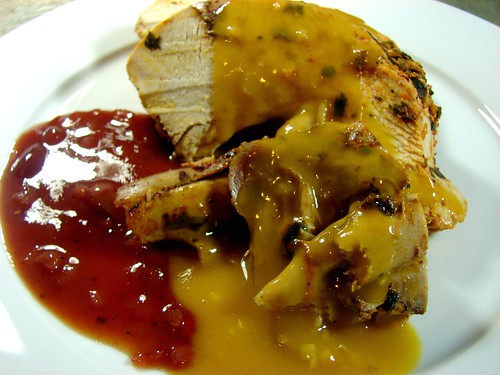
Gravy. You see that pretty gravy? Of course, you can’t have turkey without some gravy, so gravy I made. I poured the cooking liquid out of the roasting pan. Once the fat raised to the top, I scooped out about 4 tablespoons of it and heated it in a saucepan. To that I added 2 cloves of garlic finely diced, cooked them for a couple of minutes before adding 4 tablespoons of flour, stirred it in and allowed it to cook for about 5 minutes stirring constantly.
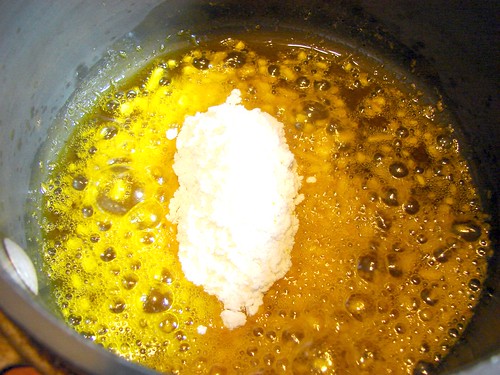
Add the reserved liquid (not the fat), be sure to keep stirring or you’ll end up with lumps and bumps. Once it boils, it will begin to thicken. At this point you can adjust the seasoning as necessary. Keep warm and pour over the sliced turkey.
And here it is. I always always always have cranberry with my turkey. Straight out of the can, I love the stuff. But, this is a Latin Thanksgiving, so no cranberries for you. Instead…
Guayaba Sauce
Guayaba, or guava as it’s known in the US, is similar in color and temperament to cranberry. By temperament I mean they have very similar flavor profiles, they’re both sweet and tart, though guayaba doesn’t have that tangy bite cranberries do. This sauce was easy to make and DELICIOUS with the turkey.
I combined about 6 ozs of guayaba paste with the juice of 2 oranges and the zest of 1 and 1 diced shallot, brought it all to a boil and seasoned with a dash of salt just before serving. That’s it!
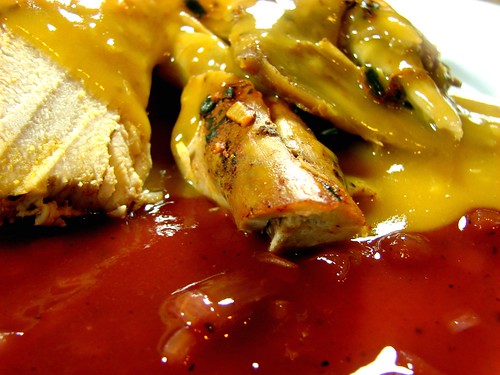
To see the recipes for the rest of this incredible meal, follow this link. To see the other food porn shots, click here.
Gobble gobble!
Cookingly yours,
Anamaris
I told you before I would make a pre-turkey day dinner for your benefit, but I lied. Don’t get me wrong, you do benefit from this, but I didn’t make this dinner just because of you. The truth is, I love turkey and would eat it year-round, so when this time of the year comes and the turkeys are plentiful… I eat and eat and, well, eat.
So, I set out to put together a Thanksgiving meal that spoke to my Latin roots while still honoring the traditional ingredients. With a little push from The Hubbz and an abandonment of safety nets, I came with what I believe is an incredible menu.

yep, that's the beginning of the menu
Pay attention, this is where you benefit: I’m about to share all of it with you! The menu. The thought process. The planning. The execution. I’m sharing it all with you in the hopes that you’ll be encouraged to recreate one or more of the dishes or that you’ll through caution to the wind and try something you’ve been thinking about for while.
The Thought Process:
Cocktails: I didn’t want anything too heavy or pumpkiny, but I still wanted to keep Thanksgiving colors in mind. I knew it needed to be spicy/flavorful.
Appetizer: I went for a soup, but wanted to keep it light while flavorful and I wanted to work sweet potatoes in the menu.
Turkey: Moist is always my first priority, so I knew I would brine it. I wanted to pick up on subtle Latin flavors without fussing too much over the bird.
Gravy: It’s like the chicken & the egg. Can’t have one without the other.
Accompanientment: Usually cranberry and, I’m sorry but I have to admit I love the canned stuff, but I needed to kick up a notch. I immediately thought guayaba! Or guava as its known stateside.
Dressing: Cornbread dressing is my absolute favorite even if traditional. My thoughts were to have corn patties topped with the extras usually found in dressing. I wanted to recreate a sophisticated version of a Panamanian tortilla.
Vegetables: Indispensable, and these pickled ones help cut through the heavy meal.
Dessert: A traditional dessert found at weddings in Panama. This is pumpkin brought to Jimmy Choo levels.
The Menu
Apricot Gingersnap Cocktail
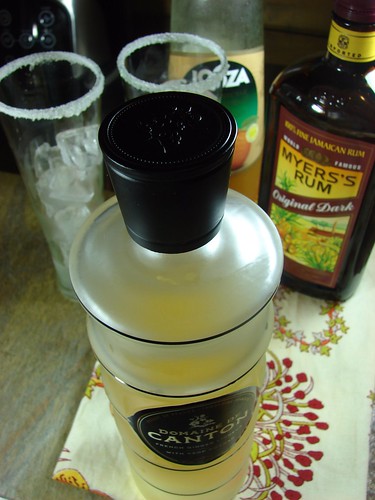
Sweet Potato Cream with Chorizo Garnish
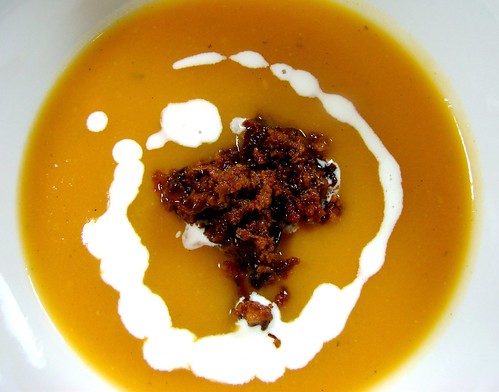
Achiote & Herbs Turkey
-Garlic Butter Gravy
-Guayaba Compote

Polenta Tortillas with Sausage & Chicharron Picadillo

Green Bean & Carrots Escabeche
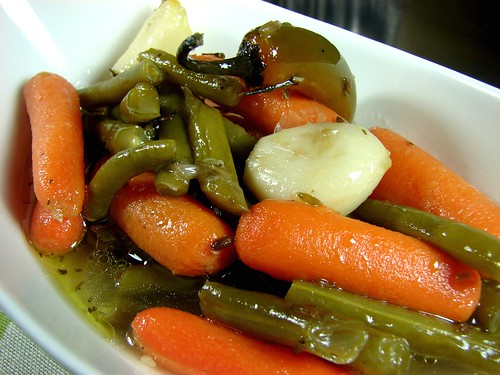
Pumpkin Sopa de Gloria

The Planning
Putting a big meal together, particularly when you have to stick to a schedule or a set dinnertime can be overwhelming. Lists make it easier. It doesn’t matter what type of project I’m working on, a list always makes me feel at ease, like I can get it done. When I just think of the big picture or the end product I can’t help but feel a bit of anxiety, like I’m going to forget something or that I don’t have enough time to finish. Lists are good. Lists are your friend.
After I had finalized the menu, I wrote down each dish and broke it down by steps. I then prioritized the order in which to execute each step.
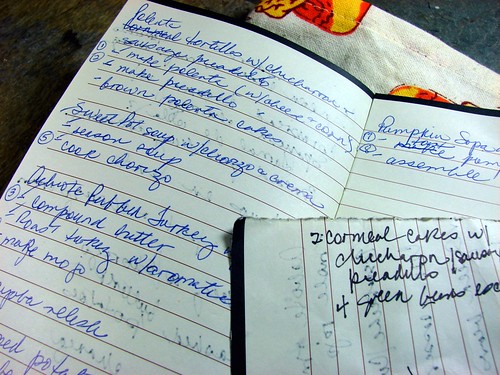
pardon my handwriting...
The Execution - for the recipes, click on the links.
Gobble, gobble!
Cookingly yours,
Anamaris
I’ve not made it yet, but I’ve been thinking about it. I can tell you that there has been some turkey action in my kitchen already. AND I will make a pre-Thanksgiving turkey turkey. It will be loved and cajoled with lots of goodness, but it doesn’t happen until later today, soooo. No post until tomorrow. Howevah (that’s a fancy Southern-drawl but) be sure to come around tomorrow, I hope to have something so sensational you’ll be happy you came.
All of this turkeypalooza is for your benefit. Yep. I do it all for you, my bloggies. I know what you’re thinking. You don’t get to eat any of it, but you could if you made it, which is why this is for you.
This post will give you a couple of ideas for the upcoming festivities. If you’ve never made turkey before, or don’t know how to spicy it up, I hope these ideas will spark the turkey fire in you.
I must first admit that I am, in fact, a briner. I am. When it comes to turkey, the birds are so large and just not fatty enough, that brining seems to be the best way to guarantee juicy plumpness. So I brine. And every year I add something new to the basic brine. But today I thought you could hear from a real Chef. I found this on CHOW yesterday, and though he doesn’t offer up a specific recipe, Michael Chiarello explains the process beautifully. I seem to be having some linking issues…, but this is the shortened link: http://bit.ly/bRwiWI
Brining does wonders for turkey, here’s what I did last year: http://wp.me/pFzw3-5V
Let’s talk a little about what I’ve been up to the last few weeks. I roasted a turkey breast. This was a little test run for the way in which I was roasting it. Wanna see?
Turkey Breast with Mexican Chorizo
I started out with a 4ish pound chicken breast, it still had bones and skin. When brining, you decide what to flavor with, the only must haves are water, salt and sugar. Remember to exaggerate the seasonings, it will all be diluted by the water. I added 2 pkts of Sazon, salt, herbs d’Provence, some Jugo Maggi and let it hang out for about an hour.

Preheated the oven to 325 and pulled out the chorizo from the casing and flattened it for easier handling. Removed the breast from the brine, dried it with paper towels and began to loosen the skin so I could squish the chorizo in. I added chorizo everywhere I could. Then drizzled the skin with olive oil and used toothpicks to secure the skin to the meat.
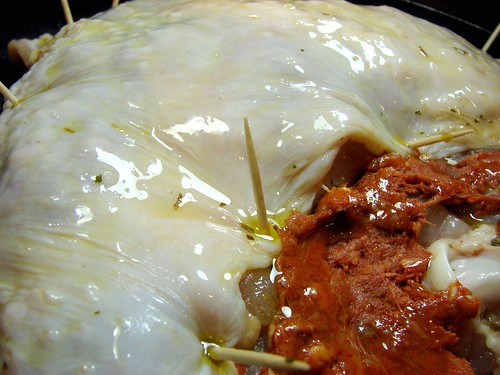
In the oven it went for close to 2 hours. I checked it after 80 minutes or so and based on the thermometer, it wasn’t quite ready. I would say just over 1-1/2 hours would’ve done it. At any rate, you want the internal temperature to read 185.
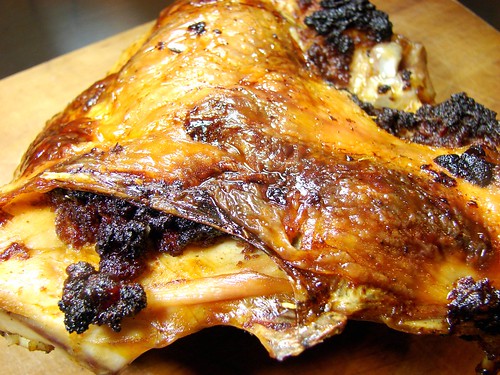
Remove the toothpicks, cover with foil and let it rest for 10 minutes or so. Remove from the bone and slice. You’ll end up with something that looks like this.
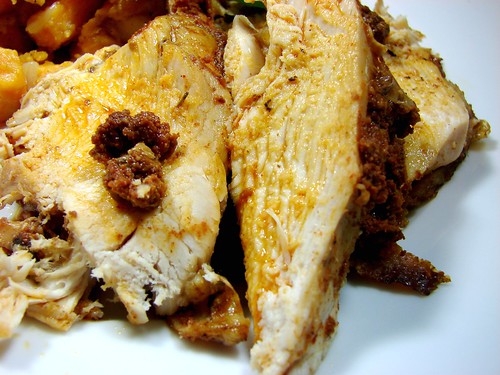
This was excellent. We paired with bacony sweet potatoes. Heaaaaaaven!

This would be a great way to make your bird, depending on the size of it, you’d probably need about 2 packets of chorizo (approx 1/2 lb).
Cookingly yours,
Anamaris










































